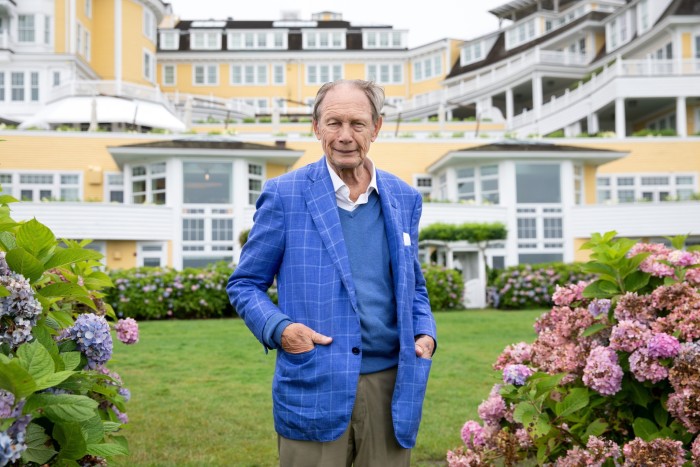
Unlock the Editor’s Digest for free
Roula Khalaf, Editor of the FT, selects her favourite stories in this weekly newsletter.
Timing the US stock market is usually a fool’s errand, a fact not lost on venerable small-cap investing pioneer Chuck Royce. Earlier this year, he and other investors focused on smaller US companies watched as they suffered their worst stint relative to larger stocks in more than two decades.
But smaller companies have seen rays of hope in recent weeks amid a sudden rotation away from Big Tech and other megacaps and into smaller, lesser-known names. As the investing climate turns sunnier for small caps, at least for now, the 84-year-old Royce this month announced plans to end his 52-year portfolio management career this autumn, transitioning to an advisory role as part of his eponymous firm’s long-term succession programme.
Royce started in finance as an equities analyst in the 1960s, and his stockpicking tenure dates to 1972, when he took over management of the Pennsylvania mutual fund, since renamed the Royce Small-Cap fund. He put his approach — eschewing the biggest names in the S&P 500 for lesser-known names with above-average profits and enticing valuations — into practice about a decade before the debut of the Russell 2000, the best-known US small-cap index.
“It’s been a very slow period for small caps until a week or two ago,” Royce told the Financial Times earlier this month. He said that if recent performance for both big and small companies continues, a small-cap boom could benefit from “a phenomenal shift in psychology, which potentially could last for a couple of years and longer”.
He joked: “I timed my retirement to be the beginning of this small-cap take-off — that was part of our plan 10 years ago.”

Royce is a “legend” in the small-cap space and “one of the last of the generation of star managers”, said Morningstar’s editorial director for manager research, Dan Culloton, praising the portfolio manager’s foresight, consistency and “entrepreneurial moxie”.
He noted that Royce’s company has been taking pains to put together teams to emulate the founder’s distinctive value approach: stocks that offer a combination of profitability, steadiness, price and competitive advantage. His flagship fund’s largest current holding is Arcosa, a provider of infrastructure-related products, which announced a 195 per cent increase in operating cash flow in May and is up about 20 per cent over the past year.
“You can’t replace an investor like Chuck, but you can try to put together teams that will carry on the philosophy and a process into the future,” Culloton said.
Royce holds an edge in small-cap value investing not only in theory but also in practice. Culloton calculated that a “wise 5-year-old” who trusted Royce’s flagship fund with $10,000 in 1975 would be sitting on about $9.5mn today.
“Of course, almost nobody did that, with the exception of maybe Chuck himself,” Culloton added. By comparison, the same investment in the S&P 500 index during that time would have returned about $3.1mn. Morningstar ranks his flagship fund in the top 20 per cent for 10-year annualised returns.
In recent years, Royce’s consistently positive returns have bumped against the seemingly inexorable trend of investors preferring passive investments and exchange traded funds to the detriment of actively managed mutual funds. Investors have pulled nearly $2tn from active mutual funds in the past five years, while ETFs have added about $3.2tn, and Royce has suffered about $4.9bn in net outflows in that time, according to data from Morningstar.
Looking back over his career, Royce called ETFs the biggest change in asset management he had seen, given their “tremendous advantage” in terms of tax treatment for investors over traditional mutual funds.
One of the biggest lessons he has learned — and a point he thinks is under-appreciated — was that there are several “vastly different” flavours of small-cap investing, such as a smaller Royce fund that invests mostly in dividend-paying companies: “There’s a variety of ways to make a lot of money.”
While his fund company “is not a terribly expensive investment shop, a boutique like Royce has never wanted to compete on price with ETFs, and that has been a difficult approach in the money management industry in the last decade or so”, Culloton said.
Royce also acknowledged that the marketplace has evolved to include specialised investment platforms such as Robinhood, and “we haven’t quite fit into that new development”.
Royce’s co-chief investment officer, Francis Gannon, is optimistic that the company’s new guard of portfolio managers will help the firm adapt and prosper while sticking to the style that Royce pioneered. Gannon was named co-chief investment officer in 2014 in preparation for Royce’s eventual exit alongside Chris Clark, now the company’s chief executive.
“Obviously, we live in a world of continuous improvement,” Gannon told the FT. “We’re looking to make sure that we can deliver on our expertise as small-cap managers in any way that people would like to see it, and that’s something that we as a firm are going to continue to work on.”
Royce’s company was acquired by Legg Mason in 2001 and changed hands again in 2020 when Franklin Templeton bought Legg Mason.
Despite having more than 50 years managing funds under his belt, Royce is actually the second-longest tenured manager of a US mutual fund, according to a review of Morningstar data. The top spot belongs to another octogenarian figure in the Franklin family: Rupert H Johnson Jr, the billionaire son of the group’s founder, uncle of current chief executive Jenny Johnson and manager since 1968 of the Franklin DynaTech fund.
Even after he has finished managing funds, Royce said he plans to continue studying smaller stocks.
“I love doing it,” he said. “And I’m probably going to do it forever.”